Steranko history of comics book 2
| série: | Etude Comics |
| dessinateur / scénariste: | Steranko James |
| éditeur: | Supergraphics EO 1972 |
| genre: | Etude |
| classement: | biblio1 |
| date: | 1972 |
| format: | broché, grand format |
| état: | TBE |
| valeur: | 30 € |
| critère: | ** |
| remarques: | the Steranko History of Comics, volume 2, 120 pages, N&B Introduction by J. Steranko - Comics (= visual storytelling) has been recognized as an art whose validity had been confirmed by mass opinion, one thing is certain, comics belong to the people - Comics' precursors for imaginative stories have been: Shakespeare (midsummer night's dream), Swift (Gulliver's travels) as well as Jules Verne, Edgar Poe, Kippling, H.G. Wells but also Homer - this volume 2 mainly studies the history of the "Funnies" (1930's), Otto Binder was the master writer of comics, he created various characters and produced 50'000 pages of comics as well as 218 stories for other publications, he opened the Binder Art Studio in New York 1) Captain Marvel - captain Marvel was born of mythological sources whereas Superman was based on a foundation of science fiction - created in 1940 by Bill Parker and Otto Binder as the writer as well as Charles Clarence Beck, then later by Jack Kirby as the artists in Whiz Comics Magazine, - captain Marvel was made out of a little orphan boy called Billy Batson who got his mighty power from an old wizard, he revealed to Billy the secret of this power resulting from the magic word: SHAZAM = - Salomon for wisdom - Hercules for strength - Atlas for stamina - - Zeus for power - Achilles for courage and Mercury for speed - originally called captain Thunder, the superhero was soon renamed captain Marvel (perhaps inspired by the success of Marvel Mystery Comics), he was mainly fighting against the villains: dr Sivana (the world's maddest scientist) and his pretty evil daughter Beautia - the style of captain Marvel (also written in script for broadcast programmes) was very simple, expressing the continual wonder of childhood and yet it became an enormous success, - this success originated perhaps in the element of humour which was added to the stories, making the strips a satire of the super-straight adventures of the super heroes, it stopped in 1953 - captain Marvel produced by the team Binder-Beck has become the hottest selling super hero of the Golden Age - in 1941, Beck opened his own art studio and additionnaly to captain Marvel created following further characters: - captain Tootsie and Tom Travis - a further particularity to captain Marvel was the linear style created by Beck which could be easily imitated, this style contributed for the strip's unusual consistancy which was not the case with Superman and Batman with a wide spectrum of variations weakening the impact of the total image - a complaint was raised in 1945 by Superman Incorporated against Fawcett Publication for unfair competition caused by captain Marvel, - captain Marvel won the case because Superman was not sufficiently copyrighted, in the final run however, Fawcett Publication stopped publishing captain Marvel to cut the costs for this legal battle and settled out of court with Detective Comics - best covers in Captain Marvel's magazine Nos 6, 47 and 60 and Whizz Comics Nos 9, 33 and 153 2) the Marvel Family - captain Marvel Junior (= first Super Boy) appeared in 1941, the notion of a super-powered boy who physically remained a boy was immediately accepted by comic readers, further characters of the Marvel Family included: - Mary Marvel - Three Lieutenant Marvels - Aunt Fanny Marvel - - Uncle Marvel - Bulletman and Black Adam (appeared only briefly) - later a funny character was also created: - Hoppy, the Marvel Funny who became captain Marvel Bunny - the main villain was Captain Nazi (a somehow attractive villain!) all these characters were presented in magazines like: - the Marvel Family, Master Comics or Wow Comics publishing companies of the Golden Age were: - Centaur - Detective Comics (D.C. National) - Fawcett - - Timely - Quality and Archie Comic Group n.b. National Publications led the field with the Archie Comic Group in second place, Quality tied for the number 3 with Timely, Fawcett and Harvey Book - this chapter 2) mostly handles the environment to which writers and drawers were confronted in those days, especially mentioned is the story of the Binder family (creator and producer of comic strips at the Binder's Art studio) being the first family of comics that changed the course of comic history - also worth mentioning was Binder's mass production method by broking down the composition of comic page into four categories: a) roughs (layouts) b) 3 pencil settings (backgrounds, secondary and main figures) c) 3 ink settings (backgrounds, secondary and main figures) d) lettering - therefore each most appropriate artist would work on a piece work basis, however sometimes they developed into practical systems which could never improve the design although commercially succesful, they were artistically unsuccesful! best covers: - in Master Comics, pages 24 and 27 - captain Marvel Junior cover No. 7 - Wow Comics (funny animals), page 37 - Mary Marvel, page 35 - the Marvel Family, page 35 n.b. in this section, there are possibly too many details which are not necessarily interesting for the normal readers 3) the Costumed Co-Stars - story about the life of the publisher Wilfred Fawcett who started operations by selling a pocket book of gags and jokes, Fawcett entered the comic's stage by publishing "Whiz Comics" with the Whiz kids which made Fawcett a leading publisher in the Golden Age history of comics, Whiz Comics proved to be one of the most succesful magazines incomic publishing history - a similar character to Mandrake was also created: IBIS the Invincible (he had however not the best impact as a super hero) - two succesful characters developed in Fawcett's comics: the Spy-Smasher fighting the villain "the Mask", ultimately Spy-Smasher went mad and had even to fight against captain Marvel, Spy-Smasher was somehow replaced later by Captain Midnight - two other characters debuted along with captain Marvel: the Golden Arrow (a western hero using a bow and arrow) and Lance O'Casey ( a red-haired sailor), they were drawn in Nickel Comics by Peter Costanza during his debut in the comic world - a famous character of that time was "Bulletman" (the arch-enemy of crime), Bulletgirl joined him later as his accomplice - Bulletman can be classified as a super hero with a particular gimmick being a gravity helmet (he had some similarities with the human torch and the Flash) other characters were: - Master Man (another Superman) - White Rajah (a Kiplingish character) - Jungle Twins (take-off of Burrough's Tarzan, Twins being the cousins of lord Greystoke) - Captain Venture (a Flash-Gordon type) - Warlock, the wizard - Minute Man (the star-spangled avenger known as the one man army) - Mister Scarlet (a red-clad reformer somehow inspired by the shadow) - the Hunchback (spine-chilling figure of the night, originating from the circus folk somehow like a freak) - the Phantom Eagle (a supernatural flying character) - Don Winslow of the Army (made also a first appearance with Joe Millard as the writer and Carl Pfeufer as the artist - Hopalong Cassidy (the movie cowboy) - Tom Mix and Bob Steele were 2 other western characters - in the early 1954, Fawcett relinquished their position as one of the top comic producers in history, the magic was gone best covers: Spy-Smasher No. 2 (p. 40), captain Midnight No. 43 (p. 41), Master Man (p. 43), Slam Bang Comics (jungle King, p. 43), Nickel Comics (Bulletman, p. 45 and 46, Wow Comics (mr. Scarlet No.3, page 50) 4) Military Comics (aerial adventures, the air battles) a) the Blackhawks - 1941 creation of the Blackhawks (angels of vengeance and messengers of destruction to all evil and injustice), invented by Charles Cuidera (influenced by Caniff) and by Reed Grandall as the drawer, their coming was a cardinal event in the history of comics because - contrary to the super heroes - they had a firm basis in reality, in fact they represented a new breed of fighting man, the 20th century flying knight - members of the Blackhawk family: André the Frenchman, Stanislaus the Polish, Hendrickson the Dutchman, Olaf the Swede, Chuck the American, Chop-Chop the mad Chinaman, - each character had his special skill in the flying squadron, one main difference with the other super heroes was the fact that Blakhawk carried a gun and used it, also curiously they wore he German outfit: Gestapo's hat and black boots - they were accompanied by many voluptuous women such as Red Laura, Queen Bee, he Black Tigress and Satana - their camaraderie was unequaled and they epitomized the "gang" format more than the justice society - Reed Randall was very skillful with the human figures which were imbued with classic grace and inspired beauty, he was also a mastery of human anatomy with faces explosively expressive, especially his women were wonderfully drawn - best covers: Military Comics (Blackhawks), Nos 16 and 27, Modern Comics (Blackhawks), No. 70 and Blackhawk Magazine No. 24 b) other flying characters: - the Air Fighters (which were not very popular) - the Black Commander (which was in fact a super plane in the shape of a bat) - Airboy (drawn by Fred Kida, he was the second greatest flying hero after Blackhawk, he piloted mainly the Black Commander) - one of the best villains fighting Airboy was the raven-haired woman aviator Valkyrie (similar to Dragon Lady) and her Airmaidens, ultimately they changed side and became the allies of Airboy, - Kida also created the Iron Ace, a knight clad in chain mail and armor plate with a two-handed broadsword - Harry Sahle created the Bald Eagle which was probably the weakest flying hero of the series, Bald Eagle had lost his hair in an aerial battle and was piloting the Flying Coffin - the Flying Dutchman, the orange air corsair, the story was of course taken from the 17th century English legend, with the Flying Dutchman being captain Vanderdecken, with his ghost ship sailing for eternity - the Black Angel was a flying heroïne, she was one of the sexiest heroïnes in comics and faced her Nazi counterpart: the Baroness Blood - Sky Wolf has a savage appearance with a white wolf's head like a hood or a cowl (large hood), he was the answer to Blackhawk but he was somehow outclassed by Blackhawk - another particular character was the Heap, a flying monster, neither man or animal, a formless slime monster that learned to feed on the oxygen taken from the veins of living creatures - the Heap became a strip of nightmare brutality (a kind of Frankenstein), but the series took also on mythic proportions with religious implications, the Heap was persecuted and died for his sins, he had to return from the dead as the immortal Heap to save mankind, he was a genuine original and his series were nevertheless masterpieces, it lasted 10 years from 1943 to 1953 and was mainly designed by Mort Leav further relatively famous series included: - Skyman, one of the most succesful avenging aviators, he became America's national hero and was created by Gardner Fox - captain Midnight, had the habit to capture his enemies shortly before midnight, he wore a winged clock as a symbol - Bill Barnes who became the Phantom Flyer - one famous magazine of that time was "Wings Comics", edited by Fiction House with magnificent covers, it contained a further flying hero: Captain Wings, the mystery pilot, other titles were: - Suicide Smith - Jane Martin, the war nurse (adding a little sex appeal) - Grease Monkey Griffin (was a token humor strip) - the Skull Squad - - the Ghost Patrol other flying characters, mainly used as fillers, did not have the same impact as the above ones, are however worth mentioning: - Rackham, the dwarf pilot - the Flying Fool (running an aircargo service) - - Wing Turner, the test pilot - Buzzard Barnes - Sky Devils - - Red Hawk, an American Indian flying hero - Skyrocket - - the Blackbird - War Eagle - Death Patrol (the foreign legion of the air) - - the Sky Sheriff - Sky Ranger - the Phantom Falcon - Bomber Burns - - Spitfire Comics - the Firebird - the Flying Fox - captain X of the RAF - - the Guardian Angel - Captain Aero - Captain Flight some other famous heroes were also involved in air adventures: - Tailspin Tommy - Barney Baxter - Johnny Hazard - Steve Canyon - - Terry and the Pirates - Don Winslow of the Navy - Smilin' Jack - - Ace Drummond - Scorchy Smith - Connie - Skyroads best covers: Air Fighters (p. 64/65), Airboy Comics (p. 67/68), the Heap (p. 70), Contact (p. 71), Spitfire Comics (p. 72), Captain Aero (p. 74), Captain Flight (p.75), Air Ace (p.76), Wings Comics (p. 78/79) 5) Police Comics - one famous character was Plastic Man, sultan of stretch, who was all parody and satire, he was a genuine original, the strip started 1941 in Police Comics magazine by Jack Ralph Cole up to 1956, - in 1942, Plastic Man got a companion: Costar Woozy Winks who was protected by the power of nature such as storm and earthquake - before drawing Plastic Man, Jack Cole created "little Dynamite", a uniformed policeman who looked like Dick Tracy, other strips were the Comet and Silver Streak, however Plastic Man was a masterpiece of kitsch although Cole's style was rather simple, but the concept behind Plastic Man was wthout precedent bearing in mind that in the 40's plastics were considered a kind of miracle product! - ultimately, Cole also collaborated in "Plaboy" contributing heavily to Playboy's humor, Cole being a natural humorist, with the characters of Plastic Man and Woozy Winks, Cole was really telling something about himself, Cole died unluckily in 1958 at the age of 43 committing suicide >> p. 86 special article by Cole: how to draw cartoons >> best covers: Plastic Man No. 1 (p. 81), Police Comics No. 26 6) the big super hero show - the history of the Quality Publication set up by Everett Arnold who produced a rainbow of heroes and heroines in his comic books starting with "Feature Comics" in 1937 - Arnold soon realized that the writers were even more important than the artists (n.b. but only for quickly drawn comic stories), however, one of the big artists working for Quality has been Bill Eisner with "the Spirit" but there was far and wide an incredible profusion of comic characters, the most famous ones: - Doll Man, started in 1939 and was Quality's first hero, he was to become the miniature Manhunter and was drawn mostly by Al Bryant - the Ray, the lightning man (one of the best costumed super hero), he was created by Lou Fine (Louis Kenneth Fine) who was one of the "finest" artists of that time, Lou Fine, the draftsman became also Lou Fine, the educator, especially for anatomy lessons, he also produced: - the Black Condor, a flying enemy of all evil appearing in Crack Comics further feature fillers of Qualité Publication were: - the Spider Widow (grandmother of terror) - the Raven (wearing a black raven's cowl) - the Swing Sisson (combining the story with jazz music) - the Jester (an inexperienced policeman) - the Clock (a kind of crimebuster similar to the Spirit) - the Spider created by Paul Gustavson, became later on the famous Spiderman - Madam Fatal, comic's first transvestite crimeslapper - Captain Triumph by Alfred Andriola, was a combination of strange Twins having the powers of flash and invisibility - Uncle Sam, created by Will Eisner appeared 1940 in National Comics (before captain America and was therefore comic's first patriot wearing a tall red, white and blue silk hat inspired byFirst World War recruiting poster "I want you" and from pulp story "Operator 5", it lasted however only until 1944 - Quicksilver, a noble king of speed - Wonderboy, the kid with superstrength from another planet - Paul Bunyan and his blue ox representing the folklore department - Merlin the Magcian with miraculous power, inherited from his ancestor in King Arthur's court some new characters also appeared in a new magazine titled "Hit Comics" with some of the most exciting and best drawn covers of superheroes: - the Red Bee, using a bee as his deterrent weapon - Neon, the Unknow using a mysterious neonic ray - Hercules, exploiting the mythological muscle character - the Swordfish, inspired by Captain Nemo of Jules Verne - Kid Eternity who had the power to call on any person in mythology or history and thus became a combination of heroes and history lessons - the Human Bomb (inspired of the Human Torch) whose touch (his explosive fists), was more devastating than dynamite, when not in action, the human bomb had to wear a pair of protective gloves then there were a series of humorous strips confirming the new humor trend in comics such as - Pen Miller, a comic artist who used both his pen and his fists to fight crime - Flatfoot Burns, a comic policeman - Candie, a female character - the Barker, a circus character - Molly the Model Breezy and Granny Gumshoe - new comic concepts were also innovated with various other characters such as (mostly issued in romance magazines): - Torchy, he blonde bombshell who was possibly the sexiest comic strip - Buccaneers and Girls in Love but the parade was now nearly over, it was 1956 best covers: >> p. 91 Feature Comics: the Doll Man (1940) >> p. 92 Feature Comics: the Doll Man (1945) >> p. 92 the Doll Man (1942) >> p. 95 Smash Comics: Midnight No. 39 (1943) >> p. 95 the Spirit No. 18 (1949) >> p. 97 Crack Comics: the Black condor No. 21 (1942) >> p. 97 Crack Comics: captain Triumph (1943) >> p. 100 National Comics: Uncle Sam No. 33 (1943) >> p. 101 Uncle Sam (1943) >> p. 102 the Red Bee >> p. 103 Hit Comics: Neon No. 9 (1941) >> p. 108 Military Comics No. 14 (1941) 7) the Spirit by William (Bill) Eisner - born and died on 2.6.1940 out of the detective and criminologist Denny Colt, the Spirit wore a black domino mask, he was soon to be accompanied by the blonde Ellen and by his official cab driver, the negro Ebony White, Spirit's home was the Wildwood Cemetery - the main villains were dr. Cobra, Mr. Midnight, the Mastermind and the Black Bow Eisner's first characters were developed 1936 with - captain Scott-Dalton, a scientist-explorer - the Flame, a pirate - Harry Karry, a secret agent as well as later on Lady Luck and Mr. Mystic, then Eisner opened his own studio (Editors Press Service) and started to work for Wow Comics with - Hawks of the Seas (a series about Carribean pirates), - the Spirit strip was first published in Police comics and finally in 1940 the Spirit got his ultimate shape and was to become one of the fre really "adult" strips in the history of comics - Eisner's brand of neo-realism was based upon real-type people in real-type situations, he translated his heroes into intricate character studies of caricature roles played by urban men, Spirit tales began to read like human interestnews stories - Eisner exploited the problems of human frailty (n.b. frailty = weakness in character or morals) but the Spirit's conspiracies were always explosive with comedy and poignancy, Eisner never missed an opportunity to also satirize commercial ventures, his inspiration came mostly from reading short stories which is being reflected in the Spirit's strip (mostly written in short stories too) and influenced also by the style of Hitchcock - the Spirit became a hero worthy of Hemingway but the sexiest females ever to slink across a comic page (n.b. to slink = move smoothly and quietly with gliding steps, in a stealthy or sensuous manner like a fox), were Eisner's women drawn with real character and the crueler the villainess, the more attractive Eisner ever made, one of the most popular figures was the witch Hazel Macbeth - the graphics were a superb world of black comedy, especially the title logos of the Spirit were drawn in ever changing original designs (see page 114), rarely had expression been under such complete control, Eisner was a scientist in the realm of precise comic timing, an artist who made virtually every pratfall a summary of the human condition (n.b. pratfall = an embarrassing failure or mistake) - in his graphics, Eisner made also much use of he film technics (high-angle, etc) with long shadows streaking along pages, but Eisner's real genius laid in the fusion of illustrations and scripts as well as in the superb physical telling of crisp, incisive stories, his graphic virtuosity remained practically unchallenged, the Spirit series finished on 28.9.1952 >> again a good documentary well-illustrated book with some quite interesting chapters such as - captain Marvel - the Flying heroes (well-designed covers of air battles, especially in the Wings Comics) - the Spirit - a second documentary vollume revealing the incredible profusion and variety of American comics, but also a hard lecture except for the interesting illustrations enclosures a) front cover (from right to left and down): - captain Marvel - the Spectre - Neon the unknown ? - Skyman - - the Ray - Spiderman - captain Midnight - Thor - captain America - - the Spirit - the Spysmasher - Nick Fury (S.H.I.E.L.D) - - Sheena - Plastic Man - the Black Angel or Cat Woman b) back cover (from right to left and down): - the Human Torch - Superman - the Doll Man - Uncle Sam - - captain Marvel Junior and Mary Marvel - Batman - Airboy - - the Black Hawks - - the Blonde Phantom (in the Spirit)- Mr. Scarlet - - Bulletman and Bulletgirl - the Silver Surfer - - Hawkgirl and Flash the fastest man alive - captain Marvel - best supporting characters by Joe Kuber (Johnny Thunderbolt, Starman, Dr. Midnite, Sandman, Spectre, Atom and dr. Fate in the hand of Hawkman - Nick Fury |
| couvertures: | 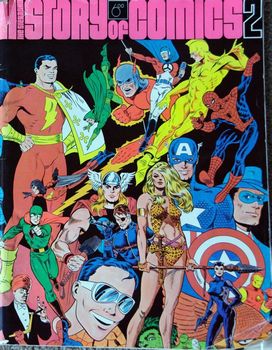 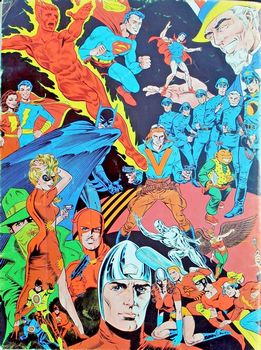 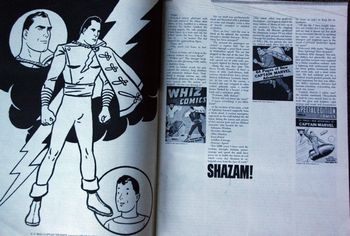 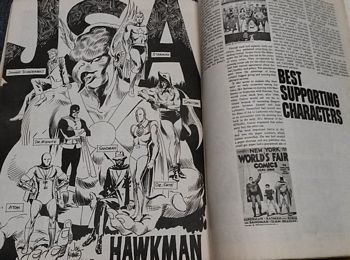 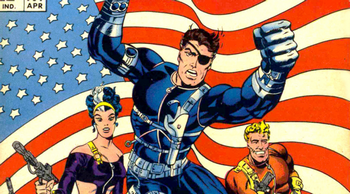 |
Copyright 2008 - 2025 G. Rudolf
